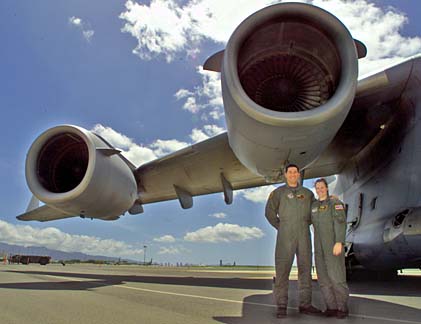

|
Guard’s cargo jet
project lifts off
A ceremony kicks off construction on
a complex to house a new C-17 squadron
Maj. C.J. Pindat Kahele and 1st Lt. Kai Kahele are the only husband-and-wife pilot team in the Hawaii Air National Guard.
By early 2006 they hope to be in the cockpit of a brand-new Globemaster jet transport as the only C-17 husband-and-wife pilot team for the Hawaii Air Guard.
|
Besides being members of the first C-17 unit stationed outside the mainland, the Kaheles also will hold the distinction of being members of the first active-duty Air Force and Air National Guard operation.
"It's really exciting to be part of this," said Kai Kahele, a 1992 Hilo High School graduate who played on the University of Hawaii men's volleyball team from 1994 to 1997.
"It's pretty awesome, growing up in Hawaii and seeing planes flying over you and then to be part of this historic undertaking by the Air Force of expanding its strategic airlift in the Pacific."
The three buildings adjacent to Hickam Air Force Base's passenger terminal are the first phase of a $190 million military construction project, said Col. Ray Torres, commander of the 15th Airlift Wing. They will support the operations of eight C-17 Globemaster jet transports. The first of eight C-17 Globemasters will arrive at Hickam in January 2006.
The Globemasters are the transportation element of the Pentagon's new mobile fighting force. The combat element will be the 2nd Brigade of the 25th Infantry Division, which by 2007 will have 3,600 soldiers using 310 eight-wheeled Stryker combat vehicles.
A C-17 jet transport can carry at least two fully equipped Strykers as far as 4,500 miles, Torres said. "But that range can be easily extended since a C-17 can be refueled midair by KC-135 jet tankers flown by the Hawaii Air Guard," Torres added.
U.S. Sen. Daniel Inouye, a key congressional supporter of the C-17 and Stryker projects, said the groundbreaking "demonstrates to our nation and the world that our active force -- the Air Force and the Guard -- can work together. This is proof positive here."
He added the new C-17 Air Force and Hawaii Air National Guard unit is a recognition by military and civilian policy-makers that "the area of concern and the area of importance" is the Pacific area.
"This aircraft is a demonstration of that," Inouye added. "The Stryker brigade is a demonstration of that."
The $30 million contract was awarded to Kiewit Pacific Construction.
After the ceremony, Torres told reporters that the Air Force is focusing on building a badly needed 3,500- to 5,000-foot training airfield near the Kona Airport on the Big Island and would share the cost of construction and usage with the state.
At one time the Air Force considered Kalaeloa, but Torres indicated that there were concerns of density, jet noise and the frequency of takeoffs and landings raised by state and federal officials during the current environmental assessment process.
